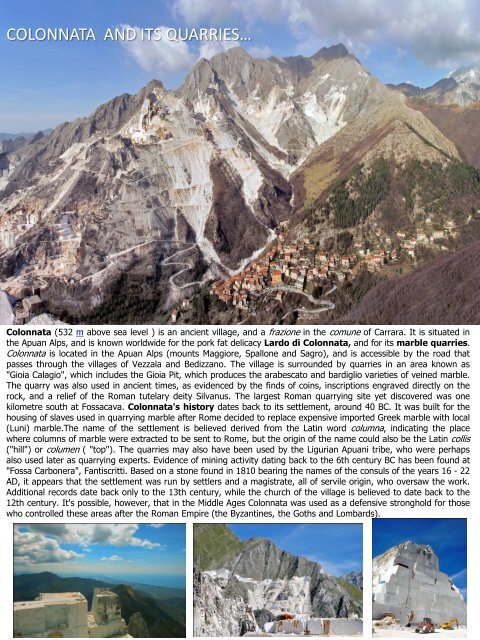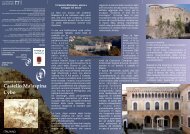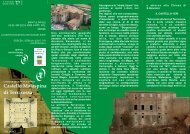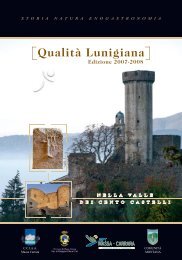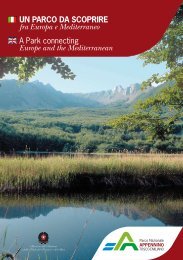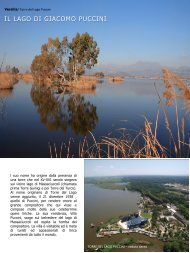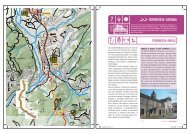Carrara the town of Quarries - CVB Versilia Costa Apuana
Carrara the town of Quarries - CVB Versilia Costa Apuana
Carrara the town of Quarries - CVB Versilia Costa Apuana
You also want an ePaper? Increase the reach of your titles
YUMPU automatically turns print PDFs into web optimized ePapers that Google loves.
COLONNATA AND ITS QUARRIES…<br />
Colonnata (532 m above sea level ) is an ancient village, and a frazione in <strong>the</strong> comune <strong>of</strong> <strong>Carrara</strong>. It is situated in<br />
<strong>the</strong> Apuan Alps, and is known worldwide for <strong>the</strong> pork fat delicacy Lardo di Colonnata, and for its marble quarries.<br />
Colonnata is located in <strong>the</strong> Apuan Alps (mounts Maggiore, Spallone and Sagro), and is accessible by <strong>the</strong> road that<br />
passes through <strong>the</strong> villages <strong>of</strong> Vezzala and Bedizzano. The village is surrounded by quarries in an area known as<br />
"Gioia Calagio", which includes <strong>the</strong> Gioia Pit, which produces <strong>the</strong> arabescato and bardiglio varieties <strong>of</strong> veined marble.<br />
The quarry was also used in ancient times, as evidenced by <strong>the</strong> finds <strong>of</strong> coins, inscriptions engraved directly on <strong>the</strong><br />
rock, and a relief <strong>of</strong> <strong>the</strong> Roman tutelary deity Silvanus. The largest Roman quarrying site yet discovered was one<br />
kilometre south at Fossacava. Colonnata's history dates back to its settlement, around 40 BC. It was built for <strong>the</strong><br />
housing <strong>of</strong> slaves used in quarrying marble after Rome decided to replace expensive imported Greek marble with local<br />
(Luni) marble.The name <strong>of</strong> <strong>the</strong> settlement is believed derived from <strong>the</strong> Latin word columna, indicating <strong>the</strong> place<br />
where columns <strong>of</strong> marble were extracted to be sent to Rome, but <strong>the</strong> origin <strong>of</strong> <strong>the</strong> name could also be <strong>the</strong> Latin collis<br />
("hill") or columen ( "top"). The quarries may also have been used by <strong>the</strong> Ligurian Apuani tribe, who were perhaps<br />
also used later as quarrying experts. Evidence <strong>of</strong> mining activity dating back to <strong>the</strong> 6th century BC has been found at<br />
"Fossa Carbonera", Fantiscritti. Based on a stone found in 1810 bearing <strong>the</strong> names <strong>of</strong> <strong>the</strong> consuls <strong>of</strong> <strong>the</strong> years 16 - 22<br />
AD, it appears that <strong>the</strong> settlement was run by settlers and a magistrate, all <strong>of</strong> servile origin, who oversaw <strong>the</strong> work.<br />
Additional records date back only to <strong>the</strong> 13th century, while <strong>the</strong> church <strong>of</strong> <strong>the</strong> village is believed to date back to <strong>the</strong><br />
12th century. It's possible, however, that in <strong>the</strong> Middle Ages Colonnata was used as a defensive stronghold for those<br />
who controlled <strong>the</strong>se areas after <strong>the</strong> Roman Empire (<strong>the</strong> Byzantines, <strong>the</strong> Goths and Lombards).


